PinotFile: 12.28 April 28, 2022
|
Windy Oaks Estate: New Pinot Noir Offerings Merit Special Praise
Jim Schultze
Regular readers know that I have been a fan of Windy Oaks wines going back to 2004. Windy Oaks was my 2018 “Winery of the Year,” and Windy Oaks Pinot Noir has appeared eight times on my annual California Pinot Noir “All-American” Teams. Jim recently contacted me and explained that a lot had happened at his winery since I last visited several years ago. A number of new Pinot Noirs have been introduced that Jim thinks are among the best he has ever produced. A number of innovations underlie recent vintages. Throughout the vineyard, Jim is using a multi-stage pruning process to help control the evenness of flowering and set; leaf pulling within the vine canopy not outside of it; avoidance of hedging (inspired by Domaine Leroy in Burgundy); a split canopy to enhance airflow and expose the clusters to more light; the use of a hot-air machine to minimize the need for chemical sprays and control undesirable insects and increase the phenolics in some of the Pinot Noir wines. In the winery, Jim is using a naturally-occurring yeast to eliminate the need for sulfur dioxide during crush; specially designed 600-liter fermentation barrels to maximize the preservation of delicate nuances of aroma and flavor in one of the wines; extension of aging on the lees to enhance mouthfeel and phenolic integration; elimination of all filtering and fining of the wines, including all white varietals. Jim put together a very interesting and unique mix of recently released Pinot Noir wines for me to review: I should emphasize that these are not “Bro wines,” that is, bigger, beefier styles of Pinot Noir that speak to a specific American audience. Instead, Jim’s wines display the qualities of Pinot Noir that most connoisseurs look for: elegance, charm, gentle power, nuance, and modest alcohol levels. The Pinot Noir wines reviewed here are not inexpensive but compare them to top-level red Burgundies which are significantly more costly. I am reminded of a quote by the Burghound, Allen Meadows who remarked, “In the search for great Pinot, you may not always get what you pay for, but you will never get what you don’t pay for.” Most Windy Oaks Estate private reserve wines such as reviewed here are sold directly to eager Wine Group members. Visit the winery’s website: www.windyoaksestate.com. All of these wines are from Windy Oaks estate vineyards except the Santa Lucia Highlands clone 943. All wines are fermented in very similar ways, with no additives other than a minimal amount of sulfur dioxide. Gravity is used throughout the winemaking process including bottling.
2017 Windy Oaks Estate Eleven:11 Santa Cruz Mountains Pinot Noir 13.4% alc., 49 cases, $58. Jim’s son, Spencer, the Windy Oaks Estate assistant winemaker, makes this unique bottling crafted from Dijon clone 943 and Calera clone. Very different from the main estate offerings, this wine is named for the project’s start date. 100% whole cluster with a long, cool fermentation with foot trodding and hand punch downs before a gentle pressing to used French oak barrels where it was aged for 24 months with no racking. After the extended elevage, this Pinot Noir was treated like a Riserva giving it another full year in tank to mature, then further aging in bottle before release, much like is seen in Brunello and Rioja wines. This strategy creates a more mature, slightly oxidative quality that fans of those wines love. · Light garnet color in the glass. The aromas really jump out of the glass including red cherry, cranberry, baking spice, burnt tobacco and pine sap. Lightly extracted with flavors of red cherry and strawberry with a spicy riff. Plenty of Pinot charm in a delicate but satisfying style with gentle tannins, subtle whole cluster input and fruit flavors that build in intensity on the finish. A very distinctive wine. Score: 93
13.7% alc., 95 cases, $85. The grapes come from an exclusively-farmed vineyard parcel that sees the use of a special piece of machinery that sends a directed blast of super-heated air in rapid motion so as to not harm the vines but gets rid of pests and reduces the need for mildew and botrytis spraying. The result is an effort to be as organic and sustainable as possible and as good as the environment can be. One of the side benefits after five years of trials is the fact that the process also dramatically increases the natural phenolics in the grape skins that are important for flavor and structure of the finished wines. · Moderately light garnet color in the glass. A seductive nose leads with aromas of dark red berry, plum, spice and sous-bois. Discrete richness on the palate with flavors that echo the aromas along with a subtle savory note. Impeccable harmony with an aristocratic, silky mouthfeel, suede tannins, and a generous and juicy finish of exceptional length. Deserving of special release. Score: 94
2018 Windy Oaks Estate Barrel Fermented Special Release Santa Cruz Mountains Pinot Noir 13.7% alc., 64 cases, $85. Jim’s comments: “A unique Pinot Noir that is fermented and aged in specially-designed 600L French oak barrels with no punchdowns and the use of indigenous yeast. The result is a wine of unusually rich flavors, texture and delicate complexity, including haunting aromatics and exceptional length. This may be the only version of Pinot Noir made by this method.” Aged 27 months without racking. · Light garnet color in the glass. Pleasing aromas of red and purple berry, cocoa powder and bramble. Light and ephemeral with succulent flavors of red cherry and berry and an appealing underlying earthiness. Excellent harmony, with no oak intrusion and good finishing length. Score: 93
2018 Windy Oaks Estate Judy's Block Special Release Santa Cruz Mountains Pinot Noir 13.7% alc., 24 cases, $110. Sourced from a half-acre block of Dijon 777 clone. Typically the grapes are blended into the Reserve, but in exceptional years (2009, 2017, and 2018), it is bottled on its own from a single barrel. The grapes are sorted both in the vineyard and again by hand in the cellar with extreme care so that only the very best grapes make it into this wine named after Jim’s wife. Native yeast fermentation and partial whole cluster. Aged for 24 months in French oak barrels. · Light garnet color in the glass. Intriguing nose with forward aromas of warm cherry pie, floral lift, and aged oak. Light to mid-weight in style, with dark red cherry and berry flavors that are broad and envelope the palate, expanding through a lip-smacking and notably lavish finish that lingers for an exceptionally long time. There are spice accents of cardamom and turmeric that I find particularly intriguing. Exquisitely balanced and clearly a special wine. Score: 96
2018 Windy Oaks Estate Special Burgundy Clone Special Release Santa Cruz Mountains Pinot Noir 13.5% alc., 24 cases, $120. The pinnacle of Windy Oaks wines that comes from the oldest parcel of the singular proprietary Burgundy clone block hand tended by Jim at the home estate vineyard. Jim brought the original cuttings to the United States from a grand cru vineyard in Vosne-Romanée. This wine is made in a single barrel lot with native yeast and partial whole cluster fermented grapes, receiving a long, cool maceration, and native malolactic fermentation, with aging on the lees for 27 months in a special custom French barrique made exclusively for Windy Oaks by artisan coopers in Burgundy. This wine is only released in vintages that are deemed to exemplify its special characteristics. · Light garnet color in the glass. Alluring, even spectacular aromas of Bing cherry, cola and spice.. The essence of black cherry is complimented by a savory tone. Substantial flavor that defies the wine's light color. Impeccably balanced with polished tannins and a lush, distinguished finish that goes on and on. Score: 95
2018 Windy Oaks Estate Deux Grand Crus Special Release Santa Cruz Mountains Pinot Noir 13.7%, 24 cases, $105. A co-fermentation of two grand crus clones originally from Burgundy (Chambertin and Vosne- Romanée). This special release is from mostly de-stemmed grapes using native yeast fermentation and a long, cool maceration period with gentle hand punch downs before being aged 24 months without racking in a new French oak barrel. The barrel is custom made for the winery with long air-dried, old growth, tight-grained staves, and a long, lower heat toasting process. · Very light ruby red color in the glass. Dreamy aromas of red cherry, baking spice, sandalwood, vanilla and sous-bois. Lighter weighted with gentle power, offering hi-tone fruit flavors of red cherry and raspberry. Soothing and polished, with a subtle oak flourish and a welcome touch of spice. The finish is of grand cru length. This wine has amazing flavor in contrast to its pale color and herein lies the greatness of Pinot Noir. This wine reminds me of a 1990 Domaine Romanée-Conti Romanée-Conti that I drank several years back. It was very light in color and delicately powered yet was definitely one of my most memorable drinking experiences. Clearly, this is not a wine for fruit hedonists. It remained seductive when tasted the following day from a previously opened bottle. Score: 97
2019 Windy Oaks Estate Mountain Block Special Release Santa Cruz Mountains Pinot Noir 13.7% alc., 64 cases, $85. The grapes come from a 1-acre parcel planted to Windy Oaks own cleaned-up version of the special Burgundy clone, sourced from cuttings that Jim originally brought back from an historic, walled grand cru vineyard in Vosne-Romanée. Barrel fermented with native yeasts in a proprietary, custom-crafted, 600L French oak barrel using 100% de-stemmed grapes that were gently crushed. Finished with RC 212 before maturing without racking for 26 months. · Light garnet color in the glass Very seductive perfume of rose petal, Bing cherry, cola, iron filings, and a hint of oak. The deep flavor of cherry creates the sensation of bombs bursting in the mouth. There is an appealing underlying roseate quality, a hint of milk chocolate and a compliment of oak.. A very distinctive and seamless wine with modest tannins and a spirited finish of good generosity. Score: 95
2019 Windy Oaks Estate Escolle Vineyard Clone 943 Santa Lucia Highlands Pinot Noir 13.4% alc., 50 cases, $49. Sourced from a small block at Escolle Vineyard that is farmed especially for Windy Oaks. The vineyard is located in the cooler, northern part of the Santa Lucia Highlands, near the well-known Garys’ Vineyard. Native yeast fermentation with elevage in 50% new French oak barrels for 23 months. · Light garnet color in the glass. The nose grows on you over time with aromas of darkest cherry, pomegranate and spice with a woody undertone. Delicious flavors of black cherry and purple berry fruits along with cardamom spice, dark chocolate, and a thin cloak of oak in the background. The tannins are sparse and the finish is moderately long. I have never tasted a 943 clone Pinot Noir that was this good and it makes for a very unique tasting wine. I would prefer less oak intrusion at this stage. Score: 93
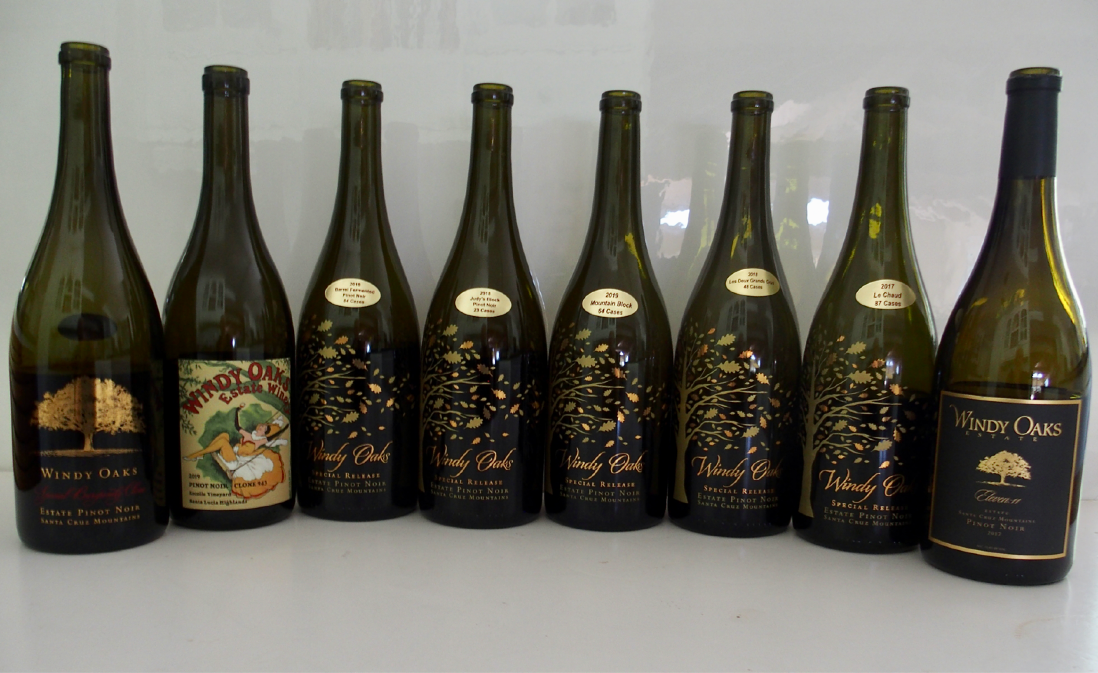
En Garde Winery: Consistently Excellent North Coast Pinot NoirEn Garde Winery is not your typical California Pinot Noir producer. The proprietor and winemaker is Csaba Szakál, a former computer programmer and a fourth-generation winemaker from Hungary. This eastern European country has a rich history of wine dating back to at least Roman times and is most renowned here in the states for Tokaji. Many of the En Garde Winery accolades in the winepress and wine competitions have focused on the winery’s Diamond Mountain Cabernet Sauvignon selections, but the Pinot Noir lineup is deserving of accolades as well. The tasting room is located in Kenwood and the wines are crafted in Sonoma Valley, atypical for Pinot Noir production compared to other parts of Sonoma County. That said, the wines are crafted from superb vineyard sources on the North Coast of Sonoma County. Csaba told me, “We enjoyed a beautiful growing season in 2019. The harvest was generous and of high quality at the same time.” All wines are bottled unfined and unfiltered. The following wines will be released in March and April 2022. Visit the website at www.engardewinery.com. Tasting is available at the Tasting Room in Kenwood and private tastings can be arranged by appointment.
2019 En Garde Sonoma Coast Pinot Noir 13.5% alc., 125 cases, $65. Clone 777 and 667 Harvest Brix 24.0º. Aged 15 months in French oak barrels, 33% new. · Light garnet color in the glass. The nose is aromatically forward showing scents of cherry, strawberry and bark. Mid-weight in style, offering flavors of red fruits and spice with a hint of oak and a savory herbal undertone. Ripe and forward, with gracious tannins and a modest but satisfying finish. Score: 91
2019 En Garde Los Carneros Pinot Noir 13.5% alc., 98 cases, $65. Clone 115 and 777. Harvest Brix 24.0º. Aged 15 months in French oak barrels, 33% new. · Moderately light garnet color in the glass. Welcoming aromas of spiced cherry, pastry and wine cellar. Forward and easy to cozy up to in a middleweight style with discretely robust flavors of black cherry, cola and baking spices. Nicely composed with civil tannins and a finish with very good cherry-driven length. Score: 93
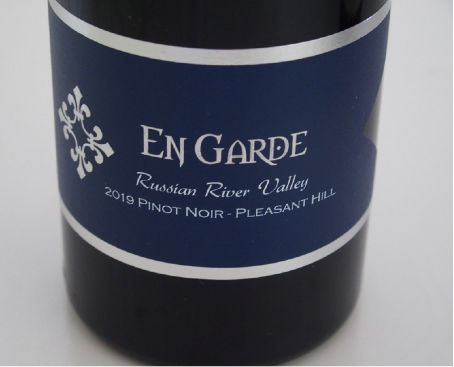 2019 En Garde Pleasant Hill Russian River Valley Pinot Noir 13.4% alc., 114 cases, $65. Clone 115, 777, and Pommard. Harvest Brix 25.0º. Aged 15 months in French oak barrels, 33% new. · Moderately light garnet color in the glass. A complex nose soars with the perfume of Bing cherry juice, ripe strawberry, rose petal, musk and a hint of ginger. Plenty of black cherry, strawberry, and cola flavors embrace the palate and carry over to a lengthy and beautifully aromatic finish. Impeccably balanced in a mid-weight plus style with an admirable touch of oak compliment. Very forward but even better when tasted the following day from a previously opened bottle. Score: 94
2019 En Garde Passion De La Reine Reserve Russian River Valley Pinot Noir 13.5% alc., 131 cases, $80. Clone 777, 115, faux 828 and Pommard. A selection of barrels. Aged 17 months in French oak barrels, 40% new. · Moderately light garnet color in the glass. Somewhat muted aromatically with demure aromas of black cherry pie, bakery, and toast. Lighter in weight than the Pleasant Hill bottling but with inviting elegance, polish, and more underlying acidity that shows up on the lip-smacking but modest finish. Still a bit tight on this occasion and I would drink the Pleasant Hill while this wine spends some time in the cellar when it should become more expressive. Score: 93
Wayfarer: Pinot Noir from a Picturesque Site on the True Sonoma CoastWayfarer Vineyard is one of the more scenic vineyard properties among the many I have visited over the years. To get an appreciation of its location, visit the video, “Discover Wayfarer Vineyard,” on YouTube. The video also introduces owner Cleo Pahlmeyer and winemaker Todd Kohn.
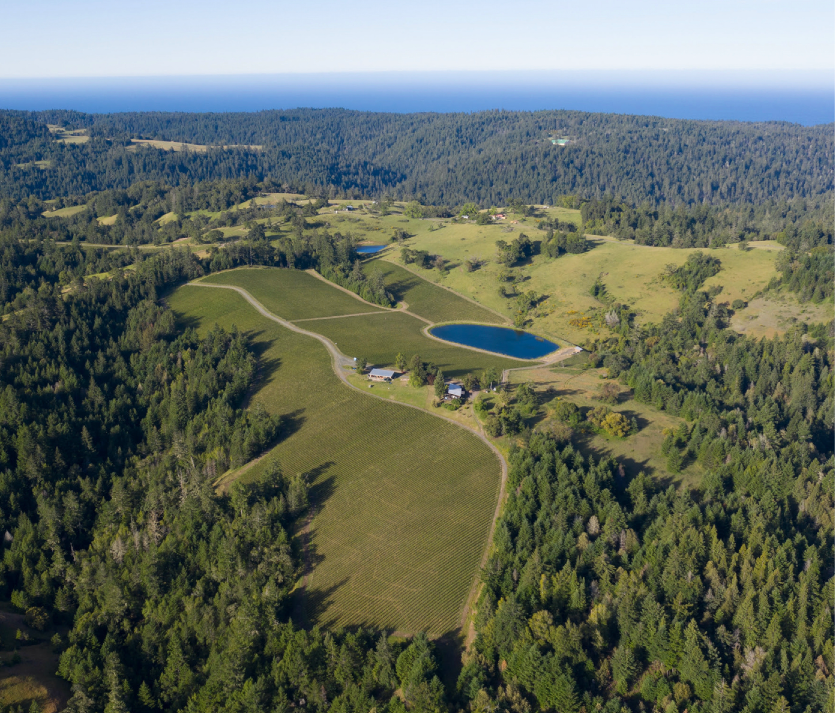
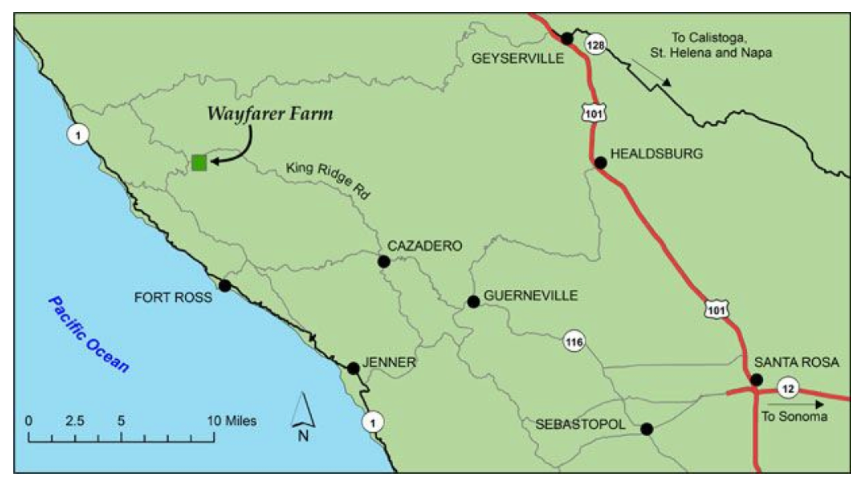 Wayfarer Vineyard is located in the Fort Ross-Seaview AVA less than 5 miles from the Pacific Ocean. At an elevation of 1100 feet, this dramatic locale is planted with 30 acres of Pinot Noir and Chardonnay. Imagine the challenges and dedication required to farm wine grapes in this rugged landscape that is far removed from the comforts of the Russian River Valley several miles to the east. The Wayfarer Vineyard was established by Jason Pahlmeyer in 1998 and the Wayfarer Vineyard label has been offered since the 2012 vintage. The wines have always garnered extremely high accolades from the wine press and have been included on my annual California Pinot Noir All-Americans List on several occasions. The winemaker since 2018 has been Todd Kohn. Several bottlings are offered including a Wayfarer Pinot Noir and special cuvées that include The Traveler, Paige’s Ridge, Mother Rock and Golden Mean. These highly recommended true Sonoma Coast wines are sold through a mailing list and online at www.wayfarervineyard.com.
2019 Wayfarer Wayfarer Vineyard Fort-Ross-Seaview Pinot Noir 14.5% alc., $90. Composed of 11 clones found in the vineyard. · Dark garnet color in the glass. Shy aromas of boysenberry, blackberry and tilled wet earth. Forward drinking with considerable charm, offering a mid-weight array of purple and black berry fruits that have good freshness and intensity. The balance is admirable, creating a welcoming drinking experience. Score: 93
2019 Wayfarer The Traveler Fort Ross-Seaview Pinot Noir 14.5% alc., $150. A block of suitcase clone that pays homage to the journey of the original vine cuttings from Burgundy. · Moderately dark garnet color in the glass. Highly perfumed with aromas of dark Bing cherry, black raspberry, vanillin and a floral lift. The nose is flat-out glorious over time. Luscious black cherry, purple grape and purple berry fruit flavors are enhanced by a riff of spice. Easily approachable with wonderful balance and an extremely long and sleek finish. Score: 95
2019 Wayfarer Paige’s Ridge Fort Ross-Seaview Pinot Noir 14.6% alc., $125. Sourced from clone 667 that is planted on the steepest slope of the eastern edge of the vineyard. · Dark garnet color in the glass. Reserved but pleasant aromas of purple and black berries, matcha tea, spice and vanilla. Very polished in the mouth, with mid-weight flavors of blackberry, black cherry, anise and an underlying earthiness. Great harmony with suave fine-grain tannins and a persistent finish. The nose was much more aromatic when the wine was tasted the following day from a previously opened bottle. Score: 94
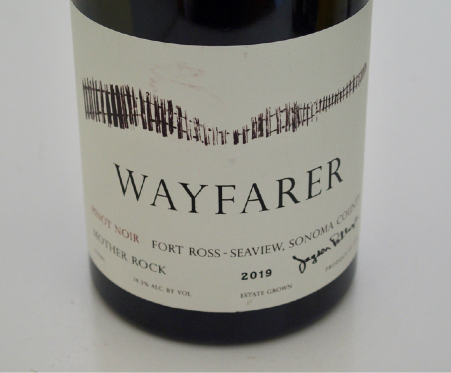 2019 Wayfarer Mother Rock Fort Ross-Seaview Pinot Noir 14.3% alc., $125. Clones 37 (Mt Eden) and 777 planted in the shallowest soil in the vineyard. · Dark garnet color in the glass. Alluring aromas of black cherry pie filling, cola and dark red rose petal. Seductively spicy with a roseate bent on the palate in a mid-weight style. Vibrant fruit flavors of dark cherry and boysenberry fill the mouth with goodness and are engaged with harmonious tannins and acidity. A departing black cherry high note is persistent and memorable. Truly, a reference wine for true Sonoma Coast Pinot Noir. Score: 96
2019 Wayfarer Golden Mean Fort Ross-Seaview Pinot Noir 14.5% alc., $125. Pommard and Swan clones. · Moderately dark garnet color in the glass. Demure aromas of blackberry, spice and toasty oak. A plethora of dark red and black fruits are framed by a compliment of oak. Shy but very suave with minimal tannins and a modest tug of acidity. The least expressive wine in the 2019 lineup initially but more inviting when tasted the following day from a previously opened bottle yet the aromas remain subdued. Cellaring or decanting is advised. Score: 93
Neely Wines from Spring Ridge VineyardNeely (actually marketed as “neely”) offers wines by the Neely family from Spring Ridge Vineyard in the Santa Cruz Mountains. The vineyard is located in Portola Valley and because of its location, is not open to the public. However, I was able to visit several years ago when the Varner brothers produced their lineup of Varner Pinot Noir and Chardonnay from this vineyard. The Chardonnay vines were first planted in 1980 by the Varner brothers and the grapes are still harvested from three Chardonnay blocks that are now legendary: Home, Amphitheater, and Bee (see Chardonnay Smackdown in this issue). In 1995, the Neely family began stewarding the property and by the early 2000s, Pinot Noir had been planted in three blocks between 1997 and 2006: Hidden, Picnic and Upper Picnic. Hidden Block is 3 acres at Dijon 115 at 730’-690’ elevation planted on sedimentary rock, Picnic Block is 2 acres planted to Dijon 777 at 645’-600’ elevation, and Upper Picnic Block: 2 acres immediately above Picnic Block planted to 777 at 660’-645’ elevation.
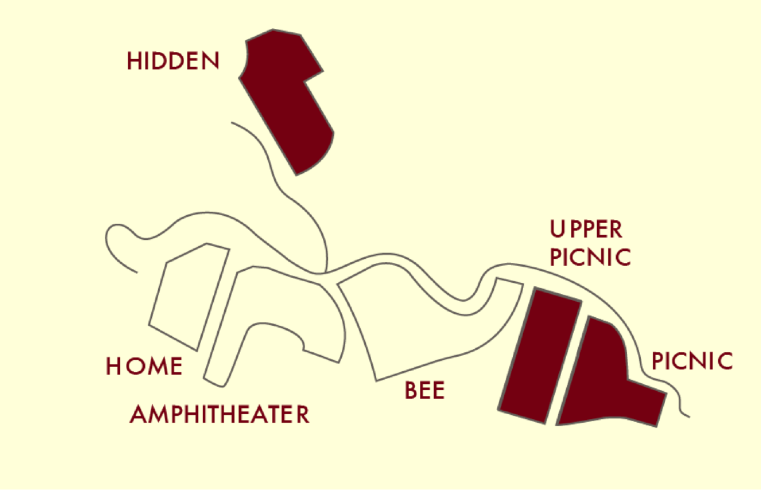 A small indoor-outdoor winery and cellar facility was completed in 2000 that initiating the era of estate winemaking. Bob Varner retired from the property in 2015 and Shalini Sekhar became the winemaker. She has an impressive resume, having worked at Williams Selyem, Copain Custom Crush, Bluxome Street Winery, ROAR, and made wines for Furthermore and Waits-Mast. Owners of Spring Ridge vineyard and Neely Wine are Dr Kirk Neely and Holly Myers. Visit www.neelywine.com for more information or to order wines. Stylistically, the Pinot Noirs in this vintage have been picked at lower Brix and are very demure. They will appeal to those who favor elegance over ripe-fruited power.
2019 neely Spring Ridge Vineyard Hidden Block Santa Cruz Mountains Pinot Noir 12.5% alc., 254 cases, $45. · Moderately light garnet color in the glass. Aromas of cranberry, vanillin and a floral lift. Relatively light in weight and elegant, offering a core of red berry flavor. Shallow on first sip, but picks up richness and length over time in the glass. Slightly underripe fruit character with a vegetal undertone. A good cut of acidity is featured on the modest finish. Score: 89
2019 neely Spring Ridge Vineyard Picnic Block Santa Cruz Mountains Pinot Noir 12.2% alc., 127 cases, $50. · Light garnet color in the glass. Nicely perfumed with aromas of earth-dusted red cherry, cola, and dark chocolate. Demure intensity on the palate but still delivers satisfying red cherry and cranberry fruit flavors. Nicely balanced, with gossamer tannins and invigorating acidity. Score: 91
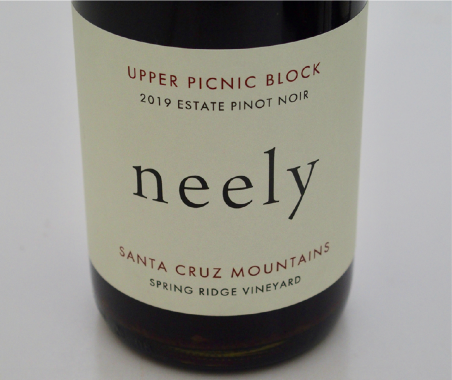 2019 neely Spring Ridge Vineyard Upper Picnic Block Santa Cruz Mountains Pinot Noir 12.7% alc., 350 cases, $50. · Light garnet color in the glass. Aromas of red cherry, strawberry and sandalwood lead off. Light to mid-weight in style and dark red fruited with no sign of under ripeness. Graceful, with silky tannins and some finishing length. Uplifting and seductive rather than hedonistic. Score: 93
Chardonnay Smackdown: Oregon vs California
Oregon Chardonnays are almost all Draper clone from California (older vines), clone 108 (older vines) and Dijon clones 76 and 96. California Chardonnay is overwhelmingly composed of Wente clones in all of its permutations and lesser amounts of heritage clones such as Mt. Eden, Robert Young, Hyde and several others. The Oregon Chardonnays tend to be more acid-driven with less oak and subtle-flavored, while the California Chardonnays tend to be more ripely fruited, more ostentatious, and embossed with more oak. I find that most Chardonnays taste more alike than different.
California2018 Dehlinger Russian River Valley Chardonnay 14.2% alc., $40. Aromas of lemon meringue pie, grilled pineapple and yellow peach. Slightly viscous, with discrete richness, offering flavors of banana, grilled lemon and yellow peach. 91 2018 Morgan Double L Vineyard Santa Lucia Highlands Chardonnay 14.2% alc., $46. Organic grapes. Clean and bright aromas of lemon, white peach and white rose petal. Lemon-focused on the palate with a kiss of oak and a long finish with a good cut of acidity. 93 2018 Rhys Horseshoe Vineyard Santa Cruz Mountains Chardonnay 12.7% alc. Wente, Hyde and Mt Eden clones grown at 1450’-1500’ elevation. Slight haze in the glass. Some reduction (slate), lemon peel and blonde rose petal on the nose. The core of lemon lime is graced by very good acidity and noticeable “minerality.” 92 2019 Dutton-Goldfield Devil’s Gulch Vineyard Marin County Chardonnay 13.5% alc., $55, $100. Very aromatic with a perfume of pineapple, poached pear and peach cobbler. Primarily fruity on the palate with flavors of lemon and Asian pear, with only a hint of nutty oak. Very pleasing liquid gold on the palate. 93 2019 Kutch Trout Gulch Vineyard Santa Cruz Mountains Chardonnay 13.0% alc., $50. 41-year-old vines, clone 17 (Robert Young) and Old Wente clones. Vineyard dates to 1977. Aged in 20% new French oak. Shy, but pleasing aromas of petrichor, slate, and lemon pie. Refreshing flavors of lemon and Asian pear underlain with energetic acidity. Bright and juicy with a slightly tart finish. 93 2019 neely Spring Ridge Vineyard Home Block Santa Cruz Mountains Chardonnay 14.0% alc., 171 cases, $52. Very floral with the aroma of peach melba. Appealing white peach and lemon flavors with good balance. 91 2019 neely Spring Ridge Vineyard Amphitheater Block Santa Cruz Mountains Chardonnay 13.0% alc., 291 cases, $55. Aromas of grapefruit and wet straw. A bit lean, and soft in the mouth, with flavors of white stone fruits and vanilla creme. 90 2019 neely Spring Ridge Vineyard Bee Block Santa Cruz Mountains Chardonnay 13.3% alc., 595 cases, $46. Perfumed with aromas of petrichor, wet sand and lemon rind. Slightly viscous in the mouth with pleasing flavors of lemon and brioche offering good length.93
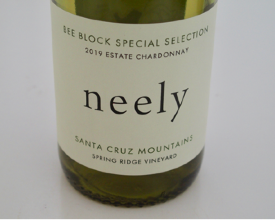 2019 neely Spring Ridge Vineyard Bee Block Special Selection Santa Cruz Mountains Chardonnay 13.1% alc., 98 cases, $55. Slightly reductive on the nose with plenty of lemon aroma. Discrete richness with a variety of fruit flavors including citrus, peach, and honeydew melon. Inviting smoothness and a creamy mouthfeel with integrated acidity. Flat-out terrific. 95
2020 Morgan Metallica Unoaked Santa Lucia Highlands Chardonnay 13.5% alc., $22. Highly aromatic with scents of lemon, grilled peach and creme soda. Good brightness on the palate with flavors of lemon-lime and white peach. Great value. 92
Oregon
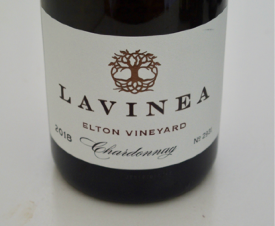 2018 Lavinea Elton Vineyard Eola-Amity Hills Chardonnay 13.8% alc., $60. Nutty oak-embossed lemon and pineapple aromas with the slightest burnt match (reductive) note. Delicious flavors of lemon, pineapple, peach, yellow apple, and toast brought to life with an arrow of acidity. A memorable lip-smacking finish. 94
2018 St. Innocent Freedom Hill Vineyard Willamette Valley Chardonnay 13.5% alc., $36. A tropical fruited nose with aromas of banana, pineapple and mango along with notes of brioche and lemon drop. The palate is also tropical fruit-driven. Sleek in the mouth with a lip-smacking finish. 92 2019 Cristom Eola-Amity Hills Chardonnay 13.0% alc., $35. Light yellow in color and endowed with aromas of lemon drop, pastry, pineapple and honeysuckle. Soft and subtle in flavor featuring a core of lemon-lime and a hint of nutty oak. 92 2019 Domaine Drouhin Arthur Dundee Hills Chardonnay 13.9% alc., $39. Estate-grown Chardonnay grapes, some of the oldest in Oregon. Both soft and juicy on the palate with hi-tone flavors of lemon, apple, and melon. Very satisfying with impeccable balance. 93 2019 Red Electric Armstrong Vineyard Alpine Lilly Ribbon Ridge Chardonnay 12.8% alc., $25. Aromas of white blossoms, pineapple and lemon. Slightly creamy with a core of rich lemon-lime flavor and a bright and lengthy finish. 92 2019 Red Electric Armstrong Vineyard Evening Primrose Ribbon Ridge Chardonnay 12.8% alc., $33. Aromas of lemon peel, wet stone, banana cream, and cookies in the oven. Slightly creamy with a lemon-driven core backed by a silhouette of oak and offering some length on the finish. 91 2019 Tan Fruit Oak Grove Vineyard Eola-Amity Hills Chardonnay 13.0% alc., $59. Pleasant aromas of lemon peel and white floral blooms. Slightly herbal with a core of lemon-lime fruit flavor. 90 2019 Tan Fruit Tank Fruit Eola-Amity Hills Chardonnay 13.0% alc., $59.Inviting aromas of lemon, white peach, floral goodness and butter. Very good lemon-driven fullness on the palate with a velvety mouthfeel. 93
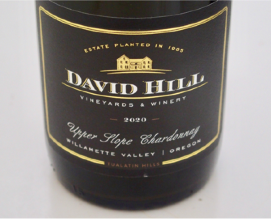 2020 David Hill Upper Slope Tualatin Hills Chardonnay 13.5% alc.. $40. Light yellow. Slightly reductive with fruit aromas of lemon-lime and guava. Flavorsome pear, apple, and lemon befriend the palate with good richness. The wine offers a sleek texture and a generous finish sporting bright acidity and amazing length. 94
2020 Walter Scott Bois-Moi Willamette Valley Chardonnay 13.0% alc., $28. Aromas of lemon peel, pineapple, and poached peer with a heavy dose of oak. A citrus jackpot with a tropical accent and energetic acidity. Too woody/herbal for my taste. 89
*****For those with deep pockets: 2019 Morlet “Ma Princesse” Ritchie Vineyard Russian River Valley Chardonnay - $105. Luc Morlet was the winemaker at Newton and Peter Michael. 98+ score by Robert Parker and 97+ score by Jeb Dunnick.
More Pinot Noir Treasures
Ellen ReddingEllen Redding Pinot Noir is a loving ode to Patrick McNeil’s grandparents and the years leading up to their wedding at St. Mary’s Church in Nicasio, Marin County, CA. Joseph Dennis McNeil courted Ellen Josephine Redding via the U.S. Postal Service from 1925 to 1928. The envelopes began as fully addressed musings to Ellen Redding was sent to 309 Fifth Avenue in San Rafael, CA. The envelopes were so colorful and frequent that the addressee eventually read as simply “Ellen, San Rafael.” More than 50 different envelopes exist, although each of the letters contained inside remains strictly between Joseph and Ellen. Each new vintage of Pinot Noir and colorful envelope tells its story. Patrick summarizes his goal: “I am a fifth generation dreamer, wanderer, and overall skeptic. I work with small, family-owned vineyards in Marin County and Napa Valley to make wines that are fruit-forward, site-specific, and off the beaten path.” His winemaking company is titled “Wines That Deliver.” Visit www.winesthatdeliver.com.
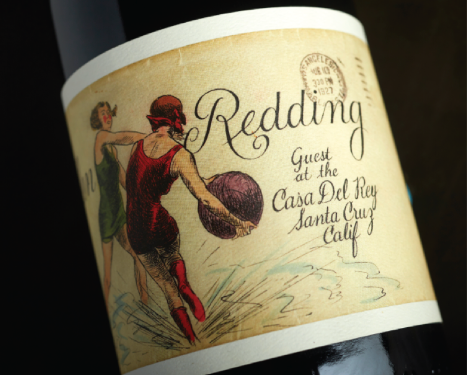 2019 Ellen Redding Marin County Pinot Noir 13.9% alc., 125 cases, $42. Sourced from two sites: Azaya Vineyard in Hicks Valley and the Chileno Valley Vineyard. Azaya Vineyard was planted to clones 667, 777, faux 828, and 115 by the duo Mark Pasternak (Devil’s Gulch Ranch) and Dan Goldfield (Dutton-Goldfield Winery). Chileno Valley Vineyard is a windswept site only 6 miles from the Pacific Ocean and also farmed by Mark Pasternak. 7-day cold soak, 1/3 whole cluster, native primary and secondary fermentations. Aged in neutral and once-used French oak barrels. Moderate garnet color in the glass. Giving aromas of cherry, boysenberry and toasty oak. A well-spiced core of cherry fruit is accompanied by tastes of cola and tobacco. Nice fruit sap but surprisingly more oak overlay considering the use of neutral and once-used barrels unless the whole cluster is responsible. Score: 92
2019 Wines That Deliver Bon Voyage Marin County Pinot Noir 14.2% alc., 75 cases, $42. Sourced from organically farmed Stubbs Vineyard. 7-day cold soak, 1/3 whole cluster native primary and secondary fermentations. Aged in neutral and once-used French oak barrels. · Moderately light garnet color in the glass. Nicely perfumed with aromas of dark cherry, ripe strawberry and earthiness. Light to mid-weight in style and cherry-driven in character with good harmony. Muted tannins with a trace of oak in the background and a pleasant finish that is moderately long. Not the richness of the Ellen Redding but plenty of charm. Score: 91
Caldwell Hill CellarsCardwell Hill Cellars was founded by Dan and Nancy Chapel in 2000 when they purchased a property with an abandoned vineyard in Philomath, Oregon. The site is located 12 miles west of Corvallis in the shadow of Mary’s Peak. New vineyards were planted and a winery was built on the property. The winery has excelled and has been featured at the International Pinot Noir Celebration. The dream continues. The original vineyard on the property was planted initially in the years 1983-1985. About one-third of the 20- acre site was planted to own-rooted Wädenswil clone Pinot Noir and the remainder to white varieties. The white varieties were removed by the Chapels after they acquired the property to make room for Pommard and Dijon 115 and 777 clones, resulting in the expansion of the vineyard to 22 acres. The vineyard was designated the Monet Vineyard. In 2002, the Chapels purchased an additional nearby 20 acres known as the Degas Vineyard planted to Dijon 115 and Wädenswil Pinot Noir and Pinot Gris. By the way, the Chapels also have a home just a half-block away from mine in North Tustin and I have known them for years. I acquired this wonderful bottle of old vine Pinot Noir at a neighboring retailer (SRP is $40). The wine is still available at www.cardhillwine.com.
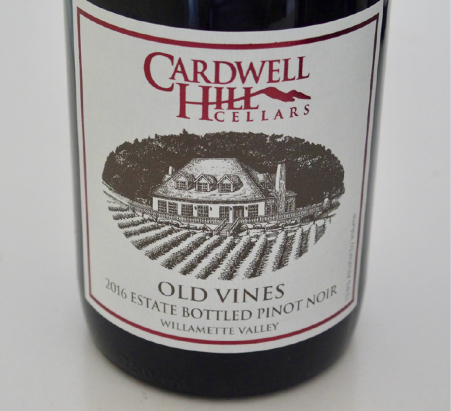 2016 Cardwell Hill Cellars Old Vines Willamette Valley Pinot Noir 13.8% alc., pH 3.50, 261 cases, $40. Fourth vintage of Old Vines Pinot Noir. A barrel selection of the best barrels of 100% Wädenswil clone planted in 1983. Harvest Brix 23.5º-24.0º. 100% de-stemmed fruit.Aged 30 months in French oak barrels, 25% new. · Light garnet color in the glass. Very pleasing aromas of blueberry, forest grove and Wassail spices. Deep flavors of brambly black raspberry, blueberry, and blackberry, with a hint of black tea and a gentle whiff of oak. Exquisitely balanced with integrated tannins, inviting acidity and an uplifting finish of good length. This wine really delivers a delightful drinking experience from 38-year-old vines, and is an excellent value as well. Score: 94
Kutch WinesOver the past year, Jamie Kutch has been developing his first estate vineyard on the Sonoma Coast. A 12- acre, abandoned apple farm in Sebastopol was purchased and planting of Pinot Noir and Chardonnay commenced this spring. Jamie expects that the property will have a cool climate much like Falstaff Vineyard, another Sonoma Coast vineyard from which he sources fruit. Jamie and his wife Kristen are committed to creating a diverse ecosystem and will be planting many species of native fruit trees and a multitude of native plants. Sheep will be raised to keep the grass down and chickens used to forage and peck below the vines to eradicate bugs and insects. Almost no wine was produced by Jamie from the 2020 vintage. Smoke from the north coast first tainted all the winery’s Pinot Noir crop except for McDougall Ranch Vineyard. Fortunately, McDougall was picked early, within days of the fires starting and before the plumes of smoke began to taint grapes in the area. McDougall is as smoke-free as the two Kutch 2020 Chardonnays. The 8-acre McDougall Ranch Vineyard was planted in 1998. It is located on Sonoma County’s far West Coast, 3.3 miles from the Pacific coastline in Cazadero and 1.7 miles north of Hirsch vineyards. The vineyard sits on a southwest-facing ridge above the fog line at 935’-1030’ elevation overlooking the Gualala River and the Pacific coastline. The clones are Dijon 114 and 115 planted in Greywacke, sandstone, and shale derived from marine sediments. An interesting fact is that the current owner, Barbara McDougall, went to high school with noted Sonoma Coast pioneering winegrower Warren Dutton. McDougall Ranch Vineyard Pinot Noir is my favorite among the many excellent Pinot Noir wines in the Kutch stable. My past scores reflect this: 2016 96, 2017 95, and 2019 95. To make up for the low volume of wine from the 2020 vintage, Kutch is now offering some library wines at original release prices. Visit www.kutchwines.com.
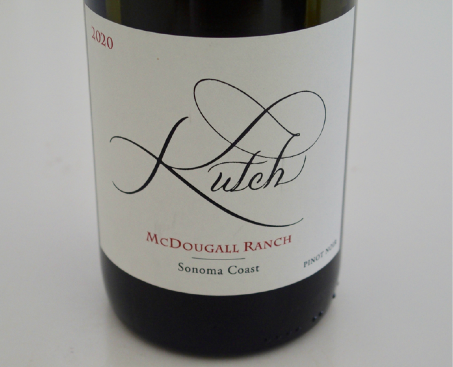 2020 Kutch McDougall Ranch Sonoma Coast Pinot Noir 13.0% alc., 275 cases, $64. Fermented 50% whole cluster with indigenous yeast. Aged in used French oak barrels. Unfined and unfiltered. · Moderately dark garnet color in the glass. Aromas of black cherry, sois-bois, floral lift, and dried herbs. Discrete fullness of dark cherry and raspberry fruit flavors with a touch of exotic spice, adroitly framed by submerged tannins and quenching acidity. A green tobacco tone was evident initially but resolved when the wine was revisited the following day at which time the overall experience had noticeably improved. Score: 93
2021 Kutch Sans Soufre Sonoma Coast Pinot Noir 12.0% alc., 100 cases, $39. Fermented 100% whole cluster with carbonic maceration and without sulfur. Jamie’s answer to Beaujolais. Aged in used French oak barrels. Bottled unfined and unfiltered. · Aromas of confected cherry and red berry along with 5-spice. Midweight plus in style, with a predominantly sweet taste of darker fruits on the palate such as blackberry and black cherry. The prominent tannins lack acidic drive to balance the wine. Score: 89
CastaliaWinemaker Terry Bering has worked as assistant winemaker and cellar master at J. Rochioli Vineyards since 1990. In 1992, he founded his own label, Castalia Wines, based on purchased grapes from Rochioli’s River Block Vineyard, a block at nearby Flax Vineyard planted to the West Block selection in the 1980s, and Dijon clones from three different Rochioli vineyards. The Castalia Pinot Noir is crafted and bottled at J. Rochioli Vineyard & Winery. I have known Terry for many years and I have reviewed every vintage from 2000 through the current 2019 release. He is one of three winemakers who are able to source Pinot Noir grapes from Rochioli Vineyard and put “Rochioli Vineyard” on his label. Vineyard-designated Pinot Noir produced by J. Rochioli is very hard to come by as it is sold to a dedicated mailing list which rarely opens up to new members. The Castalia Pinot Noir is readily available and very similar in style and character to the J. Rochioli single-vineyard Pinot Noirs. I have tried and tried to get Terry to update his website, and although to no avail, don’t be put off by it at www.castaliawines.com. Ordering is conducted to Terry by email and if you pay without a credit card, he will pay for shipping. Minimum order is 6 bottles at $60 a bottle (the price has remained constant since the 2014 vintage). There is some retail availability including, Hi-Time Wine Cellars in Costa Mesa, CA.
2018 Castalia Rochioli Vineyard Russian River Valley Pinot Noir 14.5% alc., 250 cases, $60. · Moderate garnet color in the glass. Reserved aromas of cherry cola and toast. A mouth-filling core of black cherry fruit satisfies on entry and persists through the generously aromatic finish. There is a subtle underlying jacket of oak that dissipates when the wine was retasted from an open bottle the following day. I believe decanting is of value. Score: 92
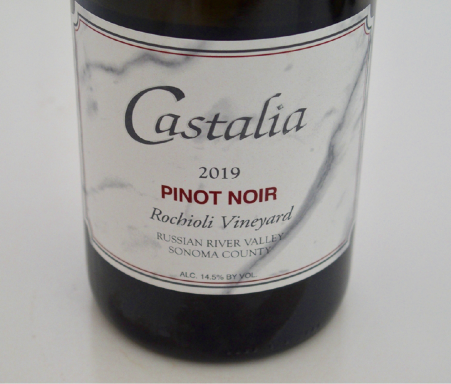 2019 Castalia Rochioli Vineyard Russian River Valley Pinot Noir 14.5 14.5% alc., 200 cases, $60. Aged 15 months in French oak barrels, 25% new. · Moderate garnet color in the glass. A pleasantly aromatic nose exhibits scents of Bing cherry, cola and baking spice. Soft on the palate in a mid-weight plus style with an expressive black cherry cola core. Refined and bright, with silky tannins. This wine is more openly friendly and charming compared to the 2018 vintage. Score: 94
Three Furies WinesThe 2019 Three Furies Wines “The Angry One” is the second of a series of three Pinot Noirs that I have reviewed. The first, “Constant Vengeance,” was an exceptional Pinot Noir. Three Furies Wines is the creation of winemaker Martin MacKenzie, a New Zealand native who crafted wines for world-renowned Stonyridge Vineyard on remote Waiheke Island in New Zealand for 10 years before moving to California wine country in 2009. The wines are sold exclusively to a mailing list at www.threefurieswines.com.
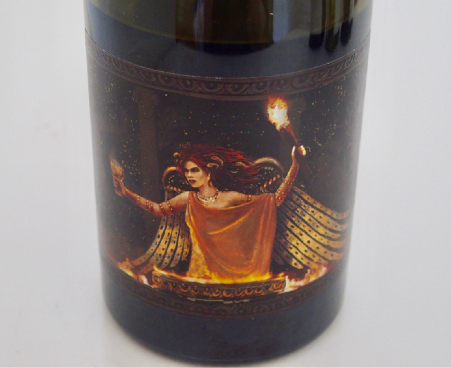 2019 Three Furies Wines The Angry One Santa Lucia Highlands Pinot Noir 14.5% alc., $55 (sold as a three pack). · Moderately dark garnet color in the glass. Reticent but pleasant aromas of dark cherry, rose petal, and worn leather. An initial hint of volatile acidity quickly dissipates. Very accommodating on the palate with a range of vivid flavors including black cherry, blackberry, spice and cola. The wine sports a silky texture, polished tannins and an inkling of oak. The finish lingers with bold, aromatic goodness. Terrific when tasted the following day from a previously opened bottle. Score: 94
Should You Avoid White Wine in Favor of the Possibly Superior Health Benefits of Red Wine?
The question of the relative health benefits of red versus white wine is an interesting one. I have not conducted a study to answer that question. I did, however, look at the last 15 years of writing about wine and health in the PinotFile as well as any peer-reviewed research that might answer this question in the scientific literature on PubMed. Here is what I found. Cornell scientist Leroy Creasy first isolated resveratrol from red wines in 1991 and later theorized that resveratrol was at least partly responsible for red wine’s health benefits. This led to a plethora of research studies on red wine and more specifically resveratrol and very few studies on white wine. Most scientific research on the health benefits of wine over the past three decades did not differentiate between red and white wine and clumped study participants into “wine drinkers.” Despite years of research, all we can say for sure is that red wine is possibly healthier than other alcoholic beverages because of its polyphenol content. It does seem very clear that the consumption of wine, particularly red wine, imparts a greater benefit in the prevention of cardiovascular disease than the consumption of other alcoholic beverages. Both red and white wine have the same amount of carbohydrates and calcium, with red wine having slightly more calories than white wine. Unique to red wine are iron, magnesium, phosphorus, potassium, choline and a much higher concentration of anti-oxidative polyphenols, organic compounds found in the skins and seeds of grapes that research has shown to provide several potential health benefits. One glass of red wine has 200 mg of polyphenols compared to 40mg for white wine primarily because red wines are macerated on their skins that contain high amounts of the group of polyphenols known as anthocyanins. The degree of polyphenol enrichment compared to white wine is the only major component difference between red and white wines. Champagne, however, has been shown to contain relatively high amounts of phenolic acids since both red and white wines are used in its production. Research published in the British Journal of Nutrition, November 30, 2009, found that people who drank moderate amounts of Champagne daily received beneficial effects on the circulatory system similar to those observed for drinkers of red wine. Although moderate consumption of red wine is thought to be healthier as a result of high polyphenol content, the alcohol in both red and white wines itself confers health benefits on imbibers such as reducing the risk of heart disease and stroke. And although both red wine and alcohol alone impart cardioprotection, the mechanisms of cardioprotection differ from each other. Research in Italy published in PLOS ONE online in 2014 suggested that white wine may be as healthy as red wine. This study focused specifically on the polyphenol caftaric acid that is found in both red and white wines and is a powerful antioxidant that may have resveratrol-like effects. The results showed that caftaric acid improved the health of arteries by increasing the availability of the vasodilator nitric oxide in lab mice. The researchers theorized that the antioxidant property of caftaric acid might explain the potential cardiovascular protection resulting from moderate white wine consumption as part of a typical Mediterranean diet. The traditional healthy Mediterranean Diet Pyramid does not distinguish between red and white wine, only that it should be consumed daily in moderation.
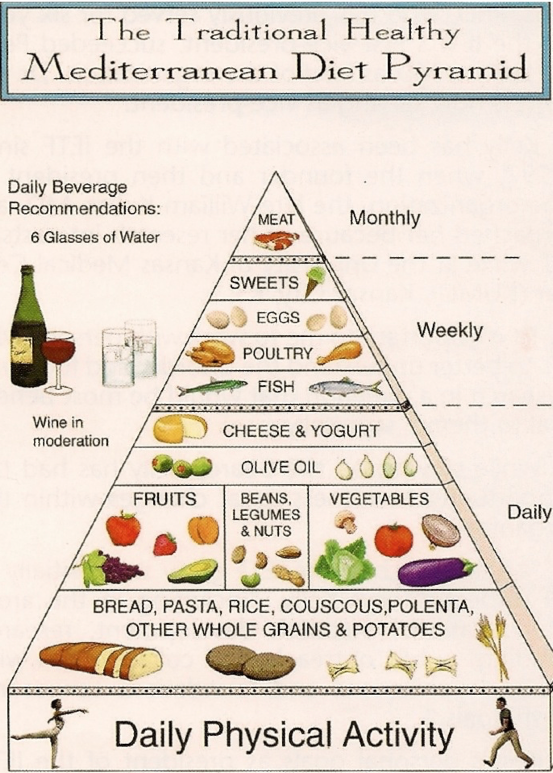 A study published in the American Journal of Enology and Viticulture in January of 1999, “Concentrations of Selected Polyphenols in White Commercial Wines,” looked at 644 white wines from major wine-producing regions. It was found in all instances, the concentration of the polyphenols measured in white wines were 5% to 25% less than those of red wines. They also showed that polyphenols’ diversity and levels are dependably due to different grape varieties and their geographical origin. Climatic factors that appear to modulate polyphenol concentrations in red wines such as stress, fungal pressure and sunlight do not seem to be important for white wines. The intrinsic properties of the individual clones together with regional differences in winemaking techniques such as skin contact may be the most important contributors in determining final polyphenol concentrations in finished wines. Recently published research in the Obesity Science & Practice Journal found that drinking wine as opposed to beer or spirits shows no association with an increased risk of elevated levels of visceral fat - the harmful type of fat that is associated with an increased risk of cardiovascular disease, metabolic syndrome, and other heath complications. Researchers also found that drinking red wine was linked to having lower levels of visceral fat. Although white wine consumption did not influence levels of visceral fat, the study did show that drinking white wine in moderation might offer its own unique health benefit for older adults: denser bones. The same link was not found between beer or red wine consumption and bone mineral density. Staining of teeth can be due to red or white wine but white wine has more acidity and more tendency to break down enamel, leaving teeth more vulnerable to pigmented food and drinks. Drinking white wine before red wine can worsen teeth staining. A study of wine-drinking subjects published in 2013 in Substance Use & Misuse from Iowa State University found that white wine pours were 9.2 percent more generous than red which may reduce the health benefits of drinking in moderation. I want to mention my personal critique of a white wine called White Pinot Noir, the bastard offspring of Pinot Noir. No decent Pinot Noir grapes should be wasted on this worthless wine that doesn’t know if it is a rosé or aromatic white, a lousy Pinot Gris or watered down Pinot Noir. In any case, it has no redeeming value and should be phased out like Gallo’s Thunderbird. Anyone who buys Domaine Serene’s Coeur Blanc (fancy term for White Pinot Noir) for $105 should seek psychiatric counseling. In summary: White wine may have been given a bad rap, so don’t avoid a glass of your favorite Chardonnay for fear that it isn’t as “healthy” as a glass of red wine. The pattern of wine drinking is more important than the type of wine you drink. One or two glasses of red or white wine consumed slowly and enjoyed most days preferably with food while avoiding splurges would seem to offer the most health benefit particularly in those over 50 years of age.
All the Wine News
Oregon Wineries Continue to Assume Corporate Ownership Constellation, the fifth largest wine company in the United State and owner of the mass-produced Meiomi brand, is buying Oregon Winery Lingua Franca. Although founder Larry Stone MS will continue as the brand’s ambassador and winemaker Thomas Savre will stay, for the time being, one wonders whether this Lingua Franca will maintain its boutique and prestigious status (Linqua Franca produces about 12,000 cases a year of Pinot Noir and Chardonnay). Who’s next to step up to winery ownership in Oregon, E.&J. Gallo? Papapietro Perry Winery Co-Founder Bruce Perry Dies Bruce and Renae Perry, along with Ben and Yolanda Papapietro, founded their namesake winery in 1998 devoted to Pinot Noir and a few other varietals such as Zinfandel.
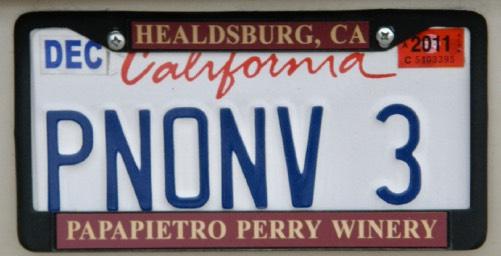 2022 State of the U.S. Wine Industry Report This survey of 633 U.S. wine businesses, most producing less than 5,000 cases annually, found that Oregon wine business owners were very unlikely to consider selling their businesses. Northern Oregon wineries reported the second-highest total revenue growth rate (24%) in 2021, ahead of Napa (17%), and trailing only Washington state (33%) among the major U.S. winegrowing regions. Oregon commands a unique niche among wine lovers willing to pay 5.5% more on average per bottle of Pinot Noir, up to $51.29 in 2021. Inaugural Willamette Valley Collectors’ Auction 89 rare and library bottlings were sold through a live-close event streamed to consumers from March 29-April 7. The auction raised $115,230. Antica Terra’s unique lot, a custom blending session garnered the top bid at $14,000 with the second-highest winning bid of $5,000 going to Alexana for their offering of a luxury winery visit for two couples and a vertical of magnums. All proceeds benefit the Willamette Valley Wineries Association programs. SLO Coast is the newest California AVA SLO Coast actually has the coolest temperatures of any California AVA. More than 90 percent of the AVA’s acreage is less than six miles from the Pacific coastline. The AVA is 750 square miles with 78 vineyards planted. SLO COAST encompasses two existing regions, Edna Valley and Arroyo Grande Valley. More than 50 wineries buy fruit from the area, and the vintners association has 32 members who include notable Pinot Noir producers Center of Effort, Chamisal Vineyards, Edna Valley Vineyard, Laetitia Vineyard & Winery, Sinor-LaVallee, Stephen ross Wine Cellars, Talley Vineyards, and Tolosa. Vintners can begin using “SLO Coast” as an official AVA name on wine bottles immediately. A majority of the plantings are Chardonnay and Pinot Noir. There are now 142 AVAs in California.
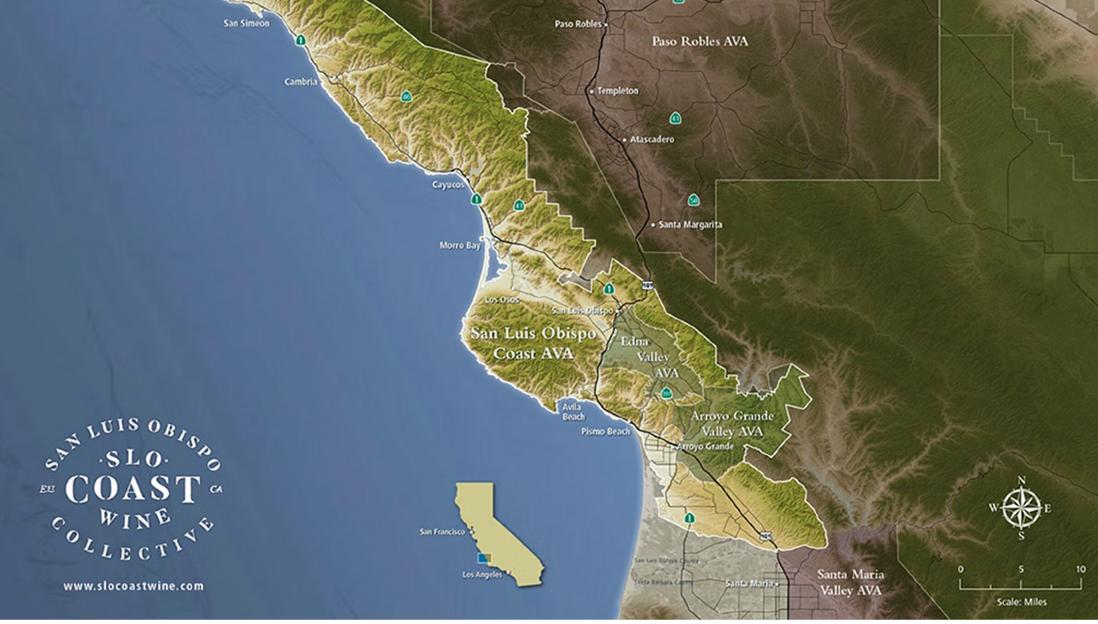 Garagista Wine Festival Returns to Sonoma 40 micro-production wineries from Napa, Sonoma, Mendocino, Lodi, Sierra Foothills and Livermore will pour at this event to be held at the Sonoma Veteran Memorial Hall on April 30. Many hard-to-find wines can only be found and tasted at this event. The Garagista Wine Festival was named “The Best Wine Festival in the USA Today’s 2018 Reader’s Choice Awards.” The event funds scholarships that support future wine professionals attending Cal POLY SLO. Visit www.garagistefestival.com. Anderson Valley Pinot Noir Festival This annual event will be held May 20-22, 2022. Friday will feature an educational seminar at the Mendocino Fairgrounds and a sunset BBQ at Goldeneye Winery, Saturday will be the Grand Tasting with more than 50 wineries pouring Pinot Noir, and Sunday will feature winery open houses at notable producers such as Foursight, Lichen Estate, Domaine Anderson, Maggy Hawk, Drew, Navarro Vineyard, Twomey, Husch and Handley. Purchase tickets at www.avwines.com. On the Wine & Health Front: A recently reported large study suggests consuming moderate amounts of alcohol (1 standard drink for women and 2 standard drinks for me) especially wine, with meals was associated with a lower risk of developing type 2 diabetes. The benefit was seen only when people drank alcohol with meals and not when it was consumed alone. A new study found that alcohol consumption did not provide additional heart benefits in cardiology patients already being treated with statins to lower cholesterol. Researchers grouped people based on how much they drank and compared these groups, finding that those who drank more experienced more deaths from heart disease. This held true for drinkers of beer, cider and spirits but when the researchers separated out wine drinkers, they found a slightly lower chance of coronary artery disease, but not other types of cardiovascular disease. New research found that half of all drinkers risk exceeding the legal driving limit by underestimating how drunk they are. They concluded that the best advice is that if you are drinking, just do not drink. A population-based study investigated associations of alcohol intake with kidney function and mortality. A higher alcohol intake in the form of wine was related to a higher glomerular filtration rate (eGFR) and to a lesser eGFR decline during an observation period ranging from 6 to 20 years. The results support the hypothesis that the intake of wine could have favorable effects on the decline in kidney function associated with ageing without implying an increased rate of mortality. A new study found that drinking beer and spirits are linked to elevated levels of visceral fat - the type of harmful fat associated with an increased risk of cardiovascular disease, metabolic syndrome, and other health complications., Drinking wine shows no such association with levels of this harmful fat and may even be protective against it, depending on the type of wine consumed. The study also found that drinking red wine specifically is linked to having lower levels of visceral fat. “Wine and Health is Never a Simple Topic” was the subject posted on the wine blog, “The Wine Gourd” at www.winegourdblogspot.com. David Morrison makes the point that everything is potentially dangerous to a living being. A new book, Drink? The New Science of Alcohol and Your Health, is authored by Professor David Nutt who has studied the impact of alcohol and health for more than 40 years.
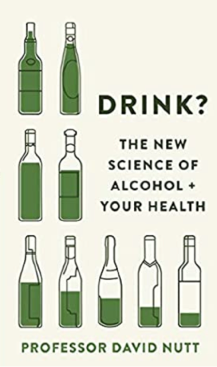 Wine Aromas Explained Jamie Goode is a prolific wine writer that I find to be the best person at explaining the complicated science of wine in an understandable manner. He recently contributed a piece to the Golden Gate Wine Cellars newsletter and I have reproduced some of his relevant comments here. Wine is full of many aromatic compounds and a good guess is around 800-1000. We detect smells through a suite of 400 different olfactory receptors, housed in olfactory receptor neurons in a patch of cells the size of a postage stamp in the back of our noses. Each person has a different subset of these receptors so we all have different thresholds for different aromas molecules. As the alcohol level goes up, many of the aroma compounds are less likely to leave the wine and so higher alcohol wines tend to be less aromatic. Fruity compounds such as esters are effectively masked by higher levels of alcohol. The aroma of wine is based on a complex interplay between the different olfactory molecules and other components of the wine. And then there is the variability that comes from us, too, with our varied olfactory systems, and also our varied experiences. So, when you are at a wine tasting don’t be intimidated when the leader says he smells “cherry,” while you only smell “strawberry.” Your taste is your patrimony. Healdsburg Wine & Food Experience The first-ever Healdsburg Wine & Food Experience, modeled after the Aspen Wine & Food Experience, will be held on May 20-22, 2022. Spend a weekend eating and drinking with Michelin-starred and James Beard award-winning chefs, meet and mingle with legendary wine experts and winemakers, and enjoy VIP farm-to-table experiences and tasting seminars and vineyard tours. The list of participating wineries includes Pinot Noir All-Stars Ancien, Banshee, Benovia, Black Kite, Cobb Wines, DuMOL, FEL Wines, Freeman V&W, Gary Farrell V&W, Hartford Court, J. Rochioli, Kistler, Kosta Browne, Kutch Wines, MacRostie W&V, Maggy Hawk, Papapietro Perry, Ram’s Gate, Sangiacomo Family Wines, Wines by James MacPhail, and Woodenhead. Choose from General Admission, VIP, or Ultra-VIP packages with the option to add on various events. Use promo code HWFEJFW22 for discounts when buying tickets at www.healdsburgwineandfood.com. IPNC Update The 2022 International Pinot Noir Celebration (IPNC) has sold out the Full Weekend packages. The Sunday Passport to Pinot tickets is available. this is a condensed version of IPNC providing access to all of the 70+ featured Pinot Noir wines and 15 Northwest chefs over the course of a 4-hour walk-around tasting in the shaded Oak Grove on the Linfield College campus. Notable wineries that are featured in 2022: Oregon - Abbott Claim, Argyle, Benton-Lane, Bergström, Bethel Heights, Big Table Farm, Brick House, Cooper Mountain Vineyards, Domaine Serene, the Eyrie Vineyards, Furioso Vineyards, Gran Moraine, Hyland Estates, J.K. Carriere, Lingua Franca, Maysara, Ponzi Vineyards, Resonance, Roco Winery, Ruby Vineyard & The winery, Soter Vineyards, Stoller Family Estate, Trisaetum, Van Duzer Vineyards, and Westrey Wine Company; California - Brewer-Clifton, Etude Wines, FEL Wines, Goldeneye, J Vineyards & Winery, Kanzler Vineyards, Keller Estate, LaRue Wines, MacRostie Winery & Vineyards, Pellegrini-Olivet Lane, Reeve Wines, Rhys Vineyards and Wayfarer Vineyard Tickets are $150 per person and are available at www.ipnc.org.
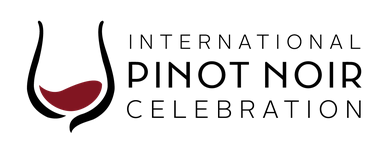 DuMOL Celebrating 25th Season of Winegrowing & Production With the release of the 2020 vintage, Russian River Valley producer DuMOL is celebrating 25 seasons of winegrowing and producing Pinot Noir and Chardonnay. To commemorate this milestone, DuMOL is releasing a 25th vintage Pinot Noir magnum, along with hosting a series of in-person and virtual events across the country for its members. Viticulturist, winemaker and co-owner Andy Smith has been at the helm of DuMOL for more than 20 years. He sources grapes from 28 vineyards, mostly concentrated in the Green Valley sub-AVA of the Russian River Valley. The winery has seven estate vineyards. DuMOL wines are released through limited allocations to its consumer mailing list and select restaurants worldwide. Visit www.dumol.com. Note: the Wallbridge fire in 2020 was to the northwest of DuMOL’s vineyards and had a negligible impact on DuMOL’s grapes in coastal Green Valley until August 26 when the prevailing strong onshore ocean wind flow subsided allowing smoke to descend to ground level. By then, DuMOL had harvested all Pinot Noir for the vintage (the vintage, along with 2015, was the earliest harvest in the winery’s history). Of course, Chardonnay grapes are gently pressed and smoke molecules accumulate and remain in the skins so there are no issues with white wines from the vintage.
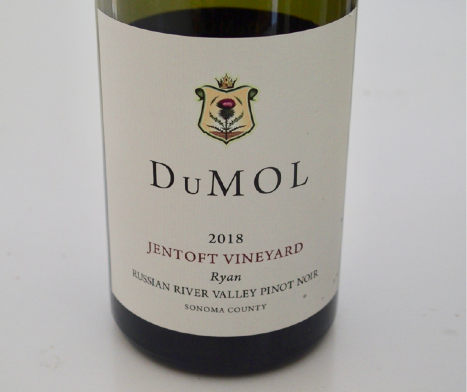
|